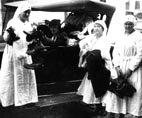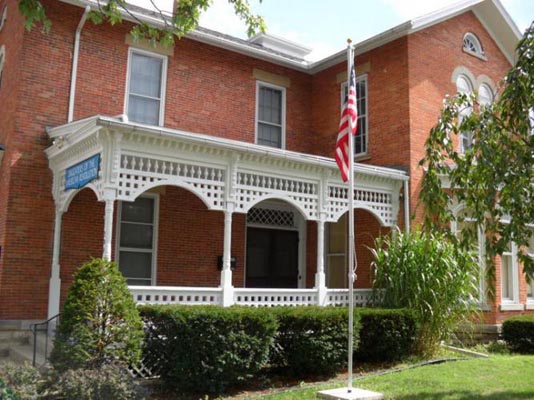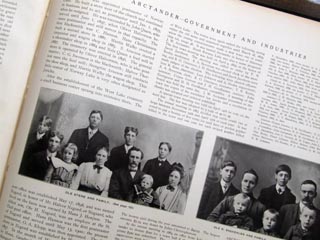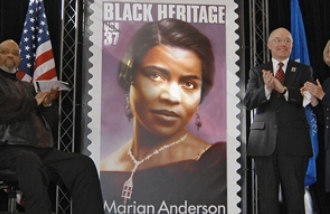In 1939, the President General, Mrs. Henry M. Robert, chose the Penny Pine program as one of her Golden Jubilee National Projects. Each state was to have a memorial forest, beginning in 1939 and culminating in 1941 on the NSDAR 50th Anniversary. Each chapter across the country was to pledge, at the very least, one acre of pine seedlings. Five dollars an acre at a penny each equals 500 trees. The Civilian Conservation Corp (CCC), under the supervision of the U.S. Forestry Service, would do the actual work of planting and care.
President Franklin D. Roosevelt proposed the CCC in 1933 to solve two problems. It would offer employment to Americans age 18-26, who were out of work because of the failing economy, and it would help the National Forests that were in deplorable condition due to over-harvesting, devastating fires, and little replanting. The CCC would revitalize our National Forests and employ millions of young people.
With new assistance from the CCC, the National Forest Service started its program of replanting and growing pines in National nurseries throughout the country. These pines would be sold to organizations and individuals for a penny each to help share with the cost of the project - hence the popular term Penny Pines. It was patriotic and popular enough that stores and post offices set up buckets for people to put pennies into, and that's how the NSDAR became involved. Some of the states could not participate due to prolonged droughts in their state and the National Forest Service recommended planting many large trees on private lands.
Read more about the DAR Forests in individual states:
ARIZONA
Many acres of Penny Pines were dedicated as a DAR Forest in 1940.
ARKANSAS
Members in this state dedicated 25 acres and a bronze marker in the White Rock Ranger District of the Ozark National Forest during the term of State Regent Mrs. Charles H. Miller as part of the Arkansas DAR Golden Jubilee Project. On March 22, 1939, the Centennial Chapter of Little Rock planted 5,000 trees in a 20-acre plot located six miles east of Mount Ida. The marker is located north of Crawford County Road 38, sadly the brass plaque is missing. The trees that appear in the historical photographs in front and on the east side of the marker are still standing. The Pine Bluff Chapter planted 4,000 trees in the Arkansas National Forest.
CALIFORNIA
The members dedicated a DAR marker and 50 acres of trees at Charlton Flats on June 18, 1940. Forty-six additional acres were planted in Mendocino National Forest and 1,200 trees were planted in Mt. Ashland watershed and dedicated as a DAR Forest on June 14, 1940.
COLORADO

Sixty acres of Engleman spruce trees were planted in Arapahoe National Forest and dedicated as a DAR Forest on August 27, 1940, in the memory of Mrs. Clarence H. Adams. Additionally, another acre was planted and a DAR Marker placed on a burned area on the mountain side of Berthoud Pass in close proximity to Denver.
CONNECTICUT
Thirty-seven large trees and thousands of seedlings, scrubs, and bulbs were planted in a 50-acre area in Latimer Grove in 1940. The Latimer Family owned property in Salem, CT. The property was sold in the 1960's, and became a Boy Scout Camp. Later in the 1980's, the property was broken off and sold again - both residentially and commercially. According to old land records and deeds, it is believed that Latimer's Grove existed in an area now called Gardener's Lake.
DELAWARE
Members of this state dedicated the planting of a DAR Forest of 10,800 Penny Pines on June 3, 1939, in Delaware State Reservation, Sussex County.
DISTRICT OF COLUMBIA
As a part of the NSDAR “Golden Jubilee” project, asked each state to plant a minimum of twenty-five acres of “penny pines”. Since the
FLORIDA

The Civil Conservation Corps planted twenty thousand pines in 1939, in the beautiful 25-acre Memorial Forest in Hillsborough River State Park, near Thonotosassa, Florida. A DAR Marker was placed on January 15, 1940, under the direction of State Regent Mrs. T. C. Maguire (Echebucsassa Chapter), and is located in the first Administration Loop, near the Ranger Station. From 1940 to 2002 the forest was left to grow. The trees lived their life expectancy and eventually the area became overgrown with hard wood. A partnership with the State Park staff and the FSSDAR was formed to accomplish the return to a natural habitat. On 22 February 2003 FSSDAR dedicated its Millennium Forest, THE SILENT SENTINELS, the project of FSSDAR State Regent Mary Lou James. Florida Daughters submitted the names of Patriot ancestors to be memorialized in the replanting of the original forest. A book listing all of the patriots and contributors was published. Native trees and shrubs typical of a long leaf pine habitat that would replicate a Florida forest that existed centuries ago were used.
GEORGIA
In 1940, in a 100-acre area known as the Richmond Walton McCurry Memorial Forest on the Chattooga River Ranger District, Chattahoochee-Oconee National Forest; 231,650 Penny Pines were planted. The pines actually planted where shortleaf pines of which some still stand today.
IDAHO
Idaho's DAR Forest and reforestation effort was the state project of Honorary State Regent Rhonda Kren (2015 - 2017). Her project was titled, "Let DAR Grow" and it came about after the Trinity Ridge Fire, north of Mountain Home in central Idaho, consumed more than 140,000 acres of forest in 2012. The fire destroyed whitebark pine trees native to the high-elevation area. Members of the Idaho State Society DAR embraced the project and two thousand whitebark pine seedlings were purchased and used to help reforest the affected area of the Trinity Ridge Mountains in the Boise National Forest. The Idaho DAR Forest dedication ceremony was held on August 26, 2019 at the Little Trinity Lakes camping area, elevation of 7,795 feet (GPS: north - 43.6293399, west - 115.4309235). A granite boulder with a bronze DAR marker was placed in the camping area to commemorate the event and state project.
ILLINOIS
The Jubilee Project for
INDIANA
Many Indiana state parks and monuments exist only through the work and contributions o.jpg) f this state's DAR members. In 1940 the Mary Parke Foster DAR Memorial Forest was established in memory of Mary Parke Foster, the third President General and native Hoosier. After World War II, State Regent Edna Taylor Burns (1916-1949) established a State Memorial Reforestation Project in Crawford County to honor the men and women from Indiana who had lost their lives during that war. On June 25, 1977, in honor of Estella Armstrong O’Byrne, Honorary President General, the “Estella O’Byrne Bird and Wildlife Sanctuary” was dedicated in the Hoosier National Forest. Other locations that Indiana Daughters contributed to include the Turkey Run State Park, Shades State Park, Penny Pines Forest in Perry County where a reforestation project was later completed, and the Caroline Scott Harrison Herb Gardens and other landscaping at the President Benjamin Harrison home in Indianapolis. If you would like to visit the Mary Parke Foster Memorial Forest, it can be located using the GPS coordinates 38.0692778, -86.6170000.
f this state's DAR members. In 1940 the Mary Parke Foster DAR Memorial Forest was established in memory of Mary Parke Foster, the third President General and native Hoosier. After World War II, State Regent Edna Taylor Burns (1916-1949) established a State Memorial Reforestation Project in Crawford County to honor the men and women from Indiana who had lost their lives during that war. On June 25, 1977, in honor of Estella Armstrong O’Byrne, Honorary President General, the “Estella O’Byrne Bird and Wildlife Sanctuary” was dedicated in the Hoosier National Forest. Other locations that Indiana Daughters contributed to include the Turkey Run State Park, Shades State Park, Penny Pines Forest in Perry County where a reforestation project was later completed, and the Caroline Scott Harrison Herb Gardens and other landscaping at the President Benjamin Harrison home in Indianapolis. If you would like to visit the Mary Parke Foster Memorial Forest, it can be located using the GPS coordinates 38.0692778, -86.6170000.
IOWA
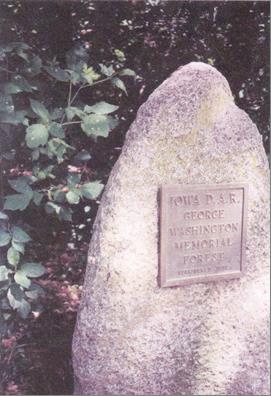
On November 5, 1932, the Iowa State Society dedicated a George Washington Memorial Forest of 110 acres along the shores of Black Hawk Lake, where 18,000 trees were planted.
KENTUCKY
The Kentucky DAR Memorial Forest is 70-acres located 5 ½ miles from Morehead in Rowan County in the Cumberland National Forest. The Forest was dedicated on October 11, 1940 by State Regent Mrs. Frederick A. Wallis with the placement of a bronze marker. Three thousand seven hundred trees, plus shrubs, perennials, and bulbs, were planted. In 2010, the forest became part of the Daniel Boone National Forest and is managed by the United States Forest Service.
LOUISIANA
Two acres of Penny Pines were planted by the DAR State Society in 1940 under State Regent Caroline Merrill Flower as a part of the NSDAR Golden Jubilee Projects. The planting was performed by the Civilian Conservation Corps.
MARYLAND
In 1940, a bronze marker was dedicated at the thirty-eight acres of Penny Pines planted in a 34-acre grove in Elk Neck Park near Northeast, Maryland.
MASSACHUSETTS

The DAR State Forest is a 1517-acre natural treasure in Goshen, the Berkshire foothills of Western Massachusetts, with miles of biking trails and dirt roads, swimming, and a number of campsites. The forest is on the state map and is managed by the Department of Environmental Management. It was established in 1929 when the Massachusetts State Society DAR donated 1,020 acres to the state. Almost 750 additional acres have been acquired since then, including the Upper and Lower Highland Lakes. Massachusetts DAR members visit the DAR State Forest in Goshen every year, and provide financial support and donation of equipment. If you want to visit the forest, the address is 78 Cape Street, Rte. 112, Goshen, Massachusetts 01032. GPS Coordinates: N 42° 27.415 W 072° 47.963
MICHIGAN
A DAR Forest of 160 acres was planted and a bronze DAR plaque was placed on a large boulder to mark the site in 1939.
MINNESOTA
 The forty-acre Minnesota DAR Memorial State Forest is on the state map located in Pine City in Pine County in the quad known as Askov Lookout Tower. The forest was dedicated in 1941. Today there is a half-mile road and overnight camping facilities.
The forty-acre Minnesota DAR Memorial State Forest is on the state map located in Pine City in Pine County in the quad known as Askov Lookout Tower. The forest was dedicated in 1941. Today there is a half-mile road and overnight camping facilities.
MISSISSIPPI
The DAR Forest was planted in 1940 by the Civilian Conservation Corp in the Chickasawhay District of the De Soto National Forest. This Ranger District is the northern unit of the
MISSOURI
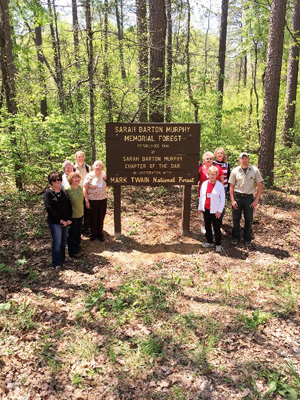
One hundred thousand trees were planted in a 100-acre area in need of reforestation in 1940. Additionally, the Sara Barton Murphy Chapter planted 40 acres of DAR Forest on US Highway 67. Sarah Barton Murphy Memorial Forest, 100 acres, established in 1940. Rededicated with new sign in 2015.
NEBRASKA
In 1941, 47 acres of Penny Pines were planted in the only National Forest in Nebraska, near Halsey. The National Forest is a unique hand-planted green island in the middle of the sand hills of central Nebraska commonly known as “Forest in the Sand”. This area is known as the “Forest in the Sand” because it is located way out west in the Sandhills of Nebraska and shares space with cactus and yucca plants. In 2009 members planted over 255 pine seedlings.
NEW HAMPSHIRE
Thirty thousand pines and a bronze marker were dedicated on June 25, 1940, at Bear Brook Park near Pembroke. The location of the marker is 243 Deerfield Rd, Allenstown, New Hampshire. GPS Coordinates: N 43° 09.620 W 071° 22.776
NEW JERSEY
Fifty acres and a bronze marker were dedicated as a
NEW MEXICO
Four DAR chapters planted eight thousand trees in 1940 on Hyde Park Road, in Hyde Memorial State Park, eight miles northeast of Santa Fe. The park is located eight miles northeast of Santa Fe, next to the Santa Fe National Forest. Hyde Memorial State Park was named after Benjamin Talbot Hyde. Situated at an elevation of 8,500 feet in the Sangre de Cristo Mountains, it is one of the oldest parks in New Mexico. The park is used for recreation, camping, skating, picnicking and sledding.
NEW YORK
The tree planting project for in 1941 took place on the Montgomery Reforestation Area No. 1. The New York Daughters provided the trees and supervised. The New York State Society furnished the funds for the employment of the labor necessary to plant the 125,000 trees on the site. A marker was erected to mark the project and dedicated on October 21, 1940.
NORTH CAROLINA
Fifty thousand trees and two bronze markers were dedicated on May 15, 1940, in the Pisgah Forest which in 1940 was not part of Biltmore. The DAR President General took part in the dedication ceremony.
NORTH DAKOTA
The 1930s Drought prevented North Dakota from establishing a DAR State Forest at that time. On September 22, 2018 the North Dakota State Society State Forest was dedicated at the North Dakota Veterans Cemetery in Mandan, North Dakota. Hundreds of trees were donated by the Minishoshe-Mandan Chapter over several years and planted in the cemetery.
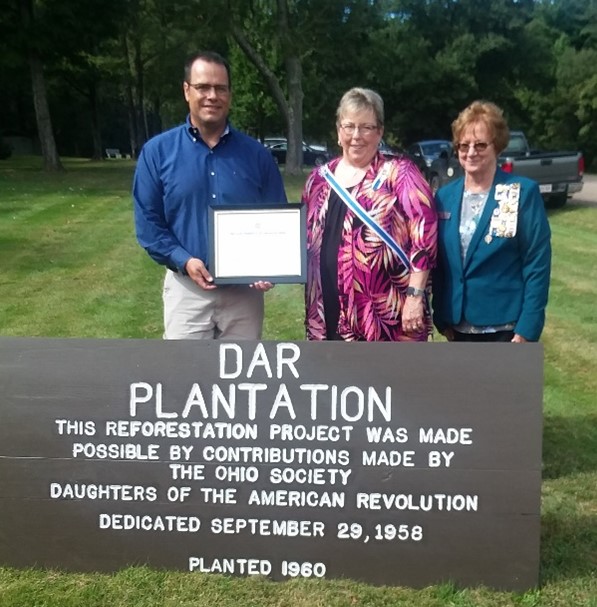
OHIO
In 1939, Ohio Daughters wholeheartedly supported President Robert's project by raising enough money to plant 18,000 white pine trees to cover 34 acres, known as the DAR Plantation, in the Mohican Memorial State Forest. The DAR Plantation Forest was originally dedicated on September 25, 1958, and on September 23, 2018, Ohio Daughters gathered once again at the DAR Plantation to celebrate the forest’s 60th anniversary with a rededication ceremony.
OKLAHOMA
DAR Chapters planted Penny Pines and Redbud trees throughout Oklahoma in 1941.
OREGON
A DAR Grove was planted in 1940 at Lythia Park, Ashland Reforestation Project, on Larch Mountain.
PENNSYLVANIA
The Pennsylvania Memorial Forest now consists of 150 acres growing from the original 106 acres and is located outside of Tidioute in the Allegheny National Forest. Seventy-five thousand trees were planted under the direction of State Regent Mrs. Joseph Forney. The memorial forest was planted with 75,000 trees at a cost of $750. Two large dedications were held after the plantings on 25 May 1940 and 21 June 1941. Heather Koech, writer of the 1999 DAR magazine article, 'Do You Know Where Your DAR Forest Is?' found another plot dedicated in 1931 to George Washington in Potter County near Couldersport, Pennsylvania. As of 2002 many of the trees are gone do to thinning of the forest. A plaque was rededicated in 2002.
SOUTH CAROLINA
From 1939 to1940, South Carolina Daughters, through the work of 31 chapters, raised funds to plant 64,500 seedlings along with 17,875 shrubs, plants and other trees.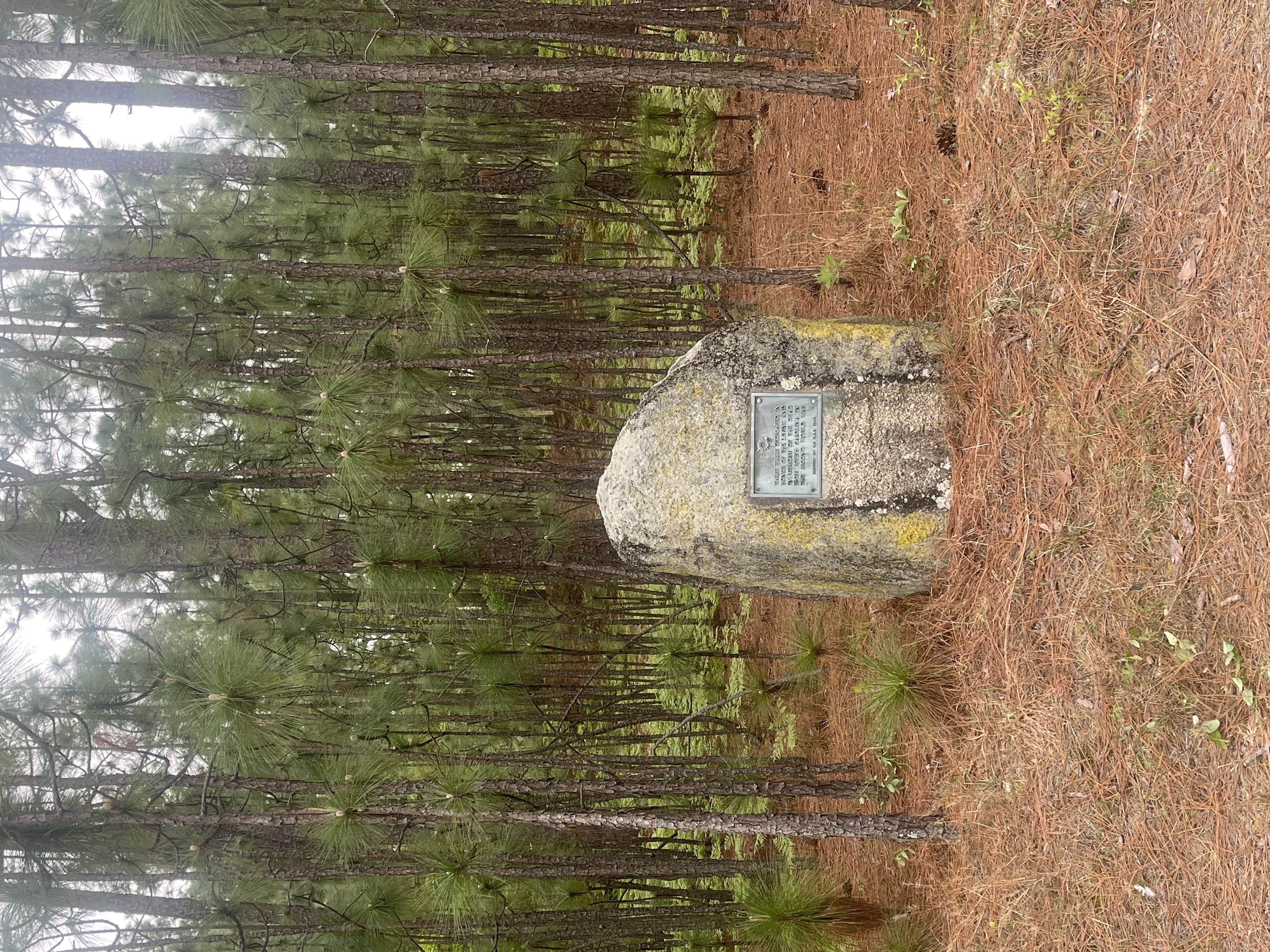
The Carolina Sandhills National Wildlife Refuge was created in 1939 and has more than 47,000 acres under protection in eastern South Carolina.
Today, the South Carolina Penny Pines Forest and the corresponding DAR marker are part of the Sand Hills State Forest. The Sand Hills Forest is made up of more than 46,000 acres of managed timberland that is the perfect backdrop for exploring, hiking, fishing, horseback riding and overnight camping.
For the traveler interested in visiting the original location of the Penny Pines Forest and seeing the DAR marker, the best address to use for a GPS is 23734 US Highway 1 McBee, SC 29101. The marker is affixed to a boulder across U.S. Highway 1 from the entrance to the Carolina Sandhills National Wildlife Refuge.
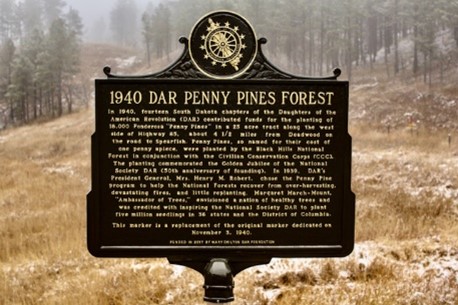
SOUTH DAKOTA
In 1940, fourteen South Dakota DAR chapters contributed funds for the planting of 18,000 Ponderosa “penny pines” on a 25 acre tract along the west side of Highway 85, about 4½ miles from Deadwood on the road to Spearfish. Penny pines, so named for their cost of one penny apiece, were planted by the Black Hills National Forest in conjunction with the Civilian Conservation Corps (C.C.C.). The planting commemorated the Golden Jubilee of the National Society DAR (50th anniversary of founding). In 1939, DAR President General Mrs. Henry M. Robert chose the Penny Pine program to help the National Forests recover from over-harvesting, devastating fires, and little replanting.
TENNESSEE
Thirty-four acres were planted in Cherokee National Forest in 1941.
VERMONT
 The State Society of Vermont DAR donated the 95-acre park in Addison to the State of Vermont in 1955, but they still operate the adjacent 1765 John Strong Museum. Located along the shores of Lake Champlain, the park offers camping, a small picnic area, boating, fishing, sailing, and swimming. Foundations remain today of the first English settlers in this area about 1765 and are located in the picnic area of the park.
The State Society of Vermont DAR donated the 95-acre park in Addison to the State of Vermont in 1955, but they still operate the adjacent 1765 John Strong Museum. Located along the shores of Lake Champlain, the park offers camping, a small picnic area, boating, fishing, sailing, and swimming. Foundations remain today of the first English settlers in this area about 1765 and are located in the picnic area of the park.
VIRGINIA
In celebration of the 150th anniversary of the United States Constitution, Virginia DAR’s Constitution Forest was dedicated as a living memorial to the Framers of the Constitution on May 14, 1938, with the planting of 28,000 red and white pine 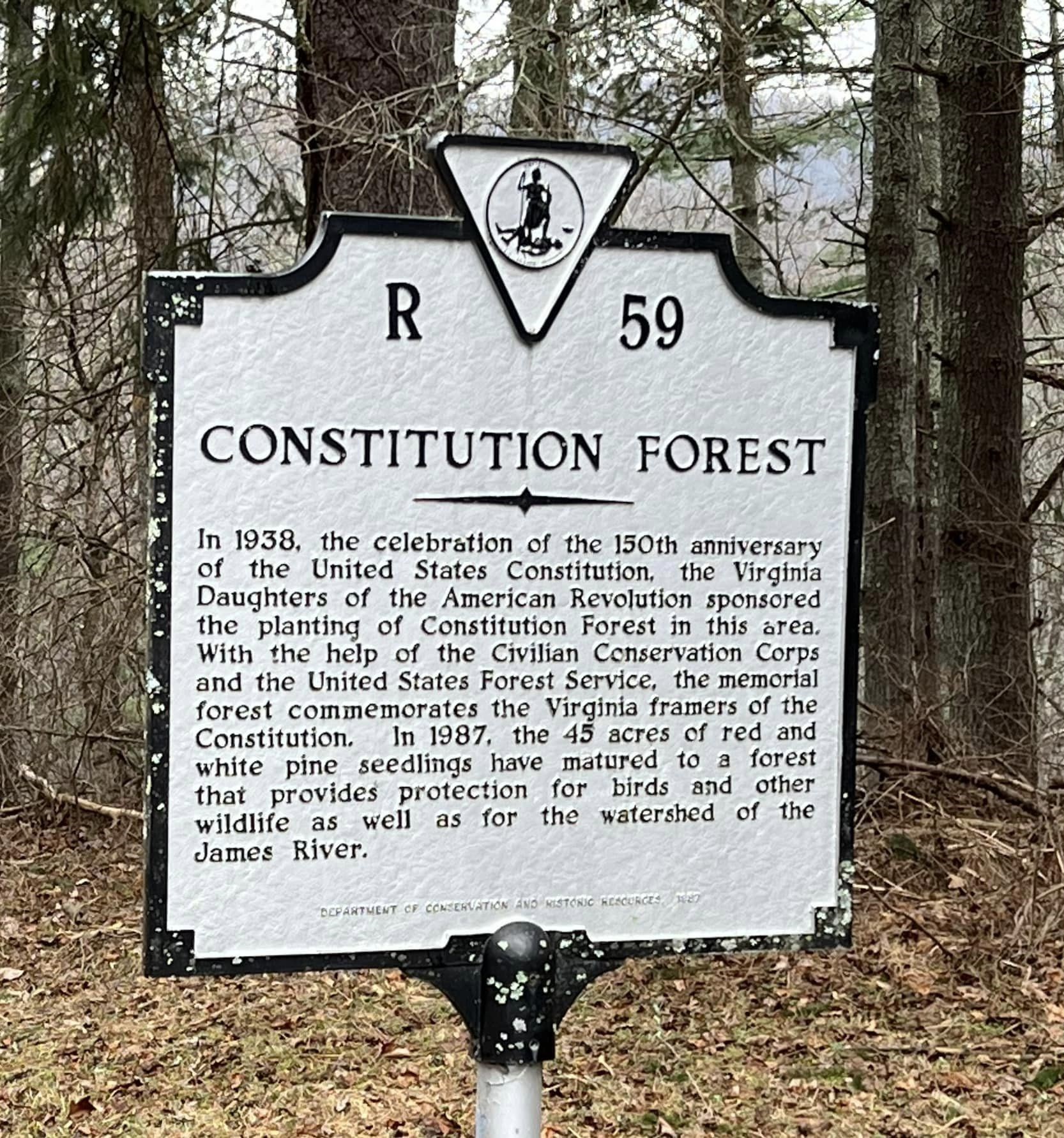 seedlings on twenty-eight acres of eroded and abandoned land in the George Washington National Forest. Also planted were eight ornamental spruce trees dedicated to the eight Virginia Framers of the Constitution. Today, Virginia Highway Marker R-59 overlooks Constitution Forest’s 45 acres. The marker is located east of Buena Vista on US Rt. 60 near its intersection with Panther Falls Road; a one car pull-off is at the site. An opportunity to enjoy the great outdoors is found four miles east of the marker on Rt. 60 – the Long Mountain Wayside which offers parking, picnic tables, and an Appalachian Trail trailhead.
seedlings on twenty-eight acres of eroded and abandoned land in the George Washington National Forest. Also planted were eight ornamental spruce trees dedicated to the eight Virginia Framers of the Constitution. Today, Virginia Highway Marker R-59 overlooks Constitution Forest’s 45 acres. The marker is located east of Buena Vista on US Rt. 60 near its intersection with Panther Falls Road; a one car pull-off is at the site. An opportunity to enjoy the great outdoors is found four miles east of the marker on Rt. 60 – the Long Mountain Wayside which offers parking, picnic tables, and an Appalachian Trail trailhead.
WASHINGTON
 The Fort Vancouver Chapter planted 3,000 trees in the Columbia National Forest in Vancouver, renamed in 1949 as Gifford Pinchot National Forest. The surviving pine trees are located on the north and south sides of the entrance to the popular Beaver Campground, Wind River Highway, north of Carson, Washington.
The Fort Vancouver Chapter planted 3,000 trees in the Columbia National Forest in Vancouver, renamed in 1949 as Gifford Pinchot National Forest. The surviving pine trees are located on the north and south sides of the entrance to the popular Beaver Campground, Wind River Highway, north of Carson, Washington.
WEST VIRGINIA
The West Virginia Daughters had been meeting at the Jackson’s Mill for years when Mr. Kendrick donated the land which was to become the West Virginia Daughters of the American Revolution Memorial where four hundred trees were planted in 1940. An amphitheater was built and dedicated on October 19, 1940.
WISCONSIN
The Brule River State forest was established in 1907 with a land gift from Fredrick Weyerhaeuser’s Nebagmon Lumber Company. In 1929, the Wisconsin
WYOMING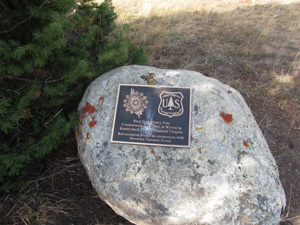
Wyoming DAR Forest, was established on September 26, 2015 in a combined celebration of the 125th Anniversary of NSDAR and Wyoming’s 125th Anniversary of Statehood. The dedication of the planting of 500 white bark pine trees in the Shoshone National Forest near Fish Lake in an effort to reforest 24,000 acre burned area in a 2006 fire. The Wyoming DAR Forest was sponsored by Freemont Chapter, NSDAR.


